Hallanic Wars: Difference between revisions
mNo edit summary |
No edit summary |
||
| Line 62: | Line 62: | ||
[[Category:Hallania]][[Category:Tuskval]][[Category:Svaldheim]][[Category:Crethia]] | [[Category:Hallania]][[Category:Tuskval]][[Category:Svaldheim]][[Category:Crethia]] | ||
The '''Hallanic Wars''' were a series of separate but related ethnic conflicts and wars of independence fought in the former [[Kingdom of Hallania]] after its defeat in the [[Continental War (Gaia)|Continental War]]. | The '''Hallanic Wars''' were a series of separate but related {{wp|ethnic conflict|ethnic conflicts}} and {{wp|war of independence|wars of independence}} fought in the former [[Kingdom of Hallania]] after its defeat in the [[Continental War (Gaia)|Continental War]]. The conflicts lasted from 1916 to 1918 and resulted in the [[Kingdom of Hallania#Dissolution|breakup]] of the Kingdom of Hallania. The conflicts were largely along ethnic lines, with the former constituent kingdoms declaring independence and separatists beginning insurgencies. | ||
The first revolt began in 1913 following the start of the [[Crethian War for Independence|Fourth Crethian Uprising]]. While the initial revolt was suppressed, Crethian nationalists and anti-monarchists organized a continued insurgency. As Hallania faced defeat in the Continental War, tensions in the other constituent realms grew. As separatists throughout the kingdom formed the Green Movement in May 1916, launching a coordinated effort to secure independence from Hallania. Initially, the Royal Hallanic Army sought to preserve the unity of the Kingdom of Hallania. However, as the conflict worsened and separatist states began to make significant territorial gains, the army came under the increasing influence of the Tuskish dominated government. As it became clear that the kingdom would breakup, the army became less interested in preserving the integrity of a united Hallania and instead worked to ensure that a "Greater Tuskval" would emerge along its pre-unification borders. As a result, the Royal Army began to lose ethnic Crethian and Svaldish supporters and effectively became a Tuskish army bolstered by loyalists in Velsken. While there were dozens of belligerents on the separatists side throughout the conflict, by April 1917 only the [[Crethia|Crethian Free State]], the [[Svaldheim|Republic of Svaldheim]], and the [[First Republic of Velsken|Republic of Velsken]] remained as belligerents against the royal government. | |||
The wars ended following the 1918 Some City Accords, resulting in the independence of [[Crethia]], [[Svaldheim]], and [[Tuskval]]. In the 1920s, the Tusko-Svaldish War saw renewed conflict in Hallania over lingering tensions that were left unresolved by the Some City Accords. Territory was exchanged between the two nations and [[Velsken]] restored its independence in 1929 after the Donhaven Accords ended the conflict. Both wars cam with a massive human cost and resulted in severe economic damage to the region. Overtime, the nations of Hallania joined together to form the [[Hallanic Commonwealth]]. This marked a formal end to lingering tensions from the Hallanic Wars and the start of cooperation between Hallanic governments. | |||
==Background== | |||
==Wars== | |||
===Crethian War for Independence=== | |||
===Other Wars=== | |||
==Foreign involvement== | |||
==War crimes== | |||
==Consequences== | |||
==Legacy== | |||
[[category:Hallania]] | |||
Revision as of 02:39, 28 December 2019
| Hallanic Wars | |||||||
|---|---|---|---|---|---|---|---|
 | |||||||
| |||||||
| Belligerents | |||||||
|
Until December 1916 |
Until December 1916 | ||||||
|
1916 - 1917 |
1916 - 1917 Other factions | ||||||
|
April 1917 - March 1918 |
April 1917 - March 1918 | ||||||
The Hallanic Wars were a series of separate but related ethnic conflicts and wars of independence fought in the former Kingdom of Hallania after its defeat in the Continental War. The conflicts lasted from 1916 to 1918 and resulted in the breakup of the Kingdom of Hallania. The conflicts were largely along ethnic lines, with the former constituent kingdoms declaring independence and separatists beginning insurgencies.
The first revolt began in 1913 following the start of the Fourth Crethian Uprising. While the initial revolt was suppressed, Crethian nationalists and anti-monarchists organized a continued insurgency. As Hallania faced defeat in the Continental War, tensions in the other constituent realms grew. As separatists throughout the kingdom formed the Green Movement in May 1916, launching a coordinated effort to secure independence from Hallania. Initially, the Royal Hallanic Army sought to preserve the unity of the Kingdom of Hallania. However, as the conflict worsened and separatist states began to make significant territorial gains, the army came under the increasing influence of the Tuskish dominated government. As it became clear that the kingdom would breakup, the army became less interested in preserving the integrity of a united Hallania and instead worked to ensure that a "Greater Tuskval" would emerge along its pre-unification borders. As a result, the Royal Army began to lose ethnic Crethian and Svaldish supporters and effectively became a Tuskish army bolstered by loyalists in Velsken. While there were dozens of belligerents on the separatists side throughout the conflict, by April 1917 only the Crethian Free State, the Republic of Svaldheim, and the Republic of Velsken remained as belligerents against the royal government.
The wars ended following the 1918 Some City Accords, resulting in the independence of Crethia, Svaldheim, and Tuskval. In the 1920s, the Tusko-Svaldish War saw renewed conflict in Hallania over lingering tensions that were left unresolved by the Some City Accords. Territory was exchanged between the two nations and Velsken restored its independence in 1929 after the Donhaven Accords ended the conflict. Both wars cam with a massive human cost and resulted in severe economic damage to the region. Overtime, the nations of Hallania joined together to form the Hallanic Commonwealth. This marked a formal end to lingering tensions from the Hallanic Wars and the start of cooperation between Hallanic governments.